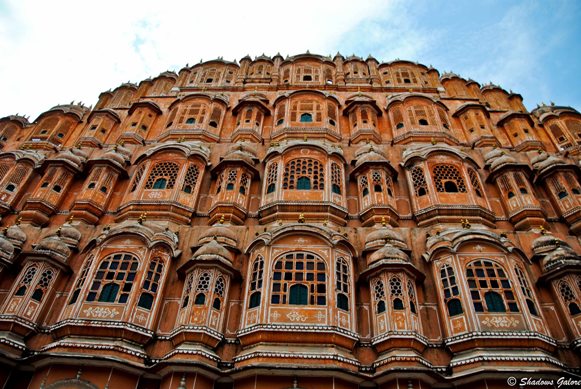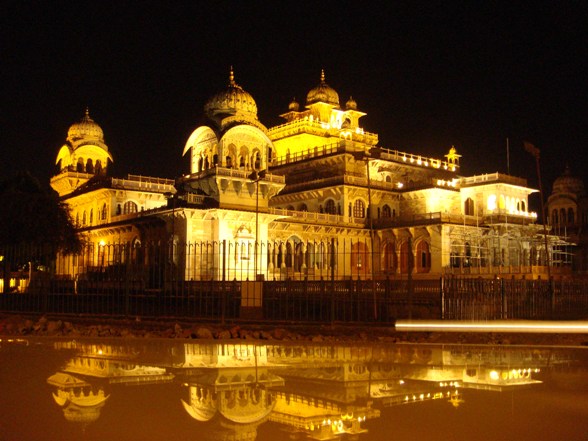Founded in 1727 by Sawai Jai Singh, Jaipur holds the credit of being the first planned city of India, at a time when much of the world was still grappling with the problems of unplanned urbanization. The city is the capital of the Indian state of Rajasthan and it has become a part of the Golden Triangle along with Delhi and Agra and is very popular as a tourist destination.
Jaipur Tourism is much more than about just pristine palaces and mighty forts. The city gives a remarkable insight into the past splendor of the Kachhwaha as well as an insight into the Rajput culture and heritage of Rajasthan.
How to Reach and go around?
Being the capital of the state, Jaipur is connected to all parts of the country by rail and road. The 6 lane Expressway joins the city to Delhi making the Delhi-Nimrana-Jaipur trip a weekend affair. The Jaipur Airport is an international Airport connecting the city to Singapore, Bangkok, Sharjah, Muscat and Dubai.
The best way to go around in city is either by Autorickshaws or taxis which offer a day sightseeing package. One can also use the local Municipal buses (No 2 from Station to City Palace, No 5 from Railway Station to Amber Fort via Hawamahal). RTDC buses are also available for sightseeing. Jaipur doesn’t have local trains but a Metro Rail is coming up in the city. However, when you are inside the Pink City; just walk.
Places of Interest
The Pink City
A Jaipur Map of the Pink City will make the visitor appreciate the vision that its builders had for the future. The city was planned as per Vastu Shastra, an ancient branch of science in India which deals with architecture in symbiosis with the elements of nature. The town is made in the form of a Circle divided into eight parts. The streets and markets are East-West aligned; while the eastern Gate is called Sujar Pol (Sun Gate), the western gate is known as the Chand Pol (Moon Gate). The gate facing the Amber fort is known as the Zorawar Singh Pol.
As for the Pink-ness of the city, the city was ordered by King Ram Singh to be painted pink to welcome the Prince of Wales to the city. The Prince came and went but the color remained and slowly became a part of the city culture.
The Amber (Amer) Fort
Built as the Royal residence of the rulers of Jaipur during 1600-1727 AD, Amber Fort (Pronounced as Amer) is located at the site of Amber which was the erstwhile capital of the Kachhwahas. The massive fort complex is built in a beautiful mix of the Rajput and Islamic styles and displays tall ramparts, extensive fortifications, beautiful palaces and sprawling courtyards within its walls. Among the most famous monuments in the Amber Fort are the Sheeshmahal (Palace of Mirrors) and the Ganesh Pol.The fort can be reached by elephants (INR 900.00 per person), or one can opt to go by a vehicle or just hike up the hillock to the gates.
Timings: 8:00 AM – 5:30 PM
Tickets:
Indians: Individuals: INR 25, Students: INR 10
Foreigners: Individuals: INR 300, Students: INR 100
Included in the 5 monument Composite Ticket? : Yes
Camera: Free
Audio Guide (recommended): INR 150
Jaigarh Fort
Around 1000 mts uphill from Amber Fort is the Jaigarh Fort. Built in 1726 AD by Sawai Jaisingh as a Military complex, this fort housed the garrison to protect Amber as well as the cannon foundry and the treasury of Jaipur. The Jaigarh fort houses the largest wheeled cannon ever made, Jaivana which was so huge that it was fired just once, sending the cannon ball 35 km away! The fort also provides a scenic view of the Amber Fort from above.
Timings: 9:00 AM – 6:00 PM
Tickets:
Indians: Individuals: INR 35
Foreigners: Individuals: INR 85
Camera: Still: INR 50, Video: INR 200
Guide: INR 30-50
Nahargarh Fort
Built in 1734 by Sawai Jaisingh, the Nahargarh fort was built as a retreat as well as to provide strategic depth to the defense of Jaipur. It is smallest of the three forts of Jaipur. The fort complex houses the beautiful Madhavendra Bhawan Palace with its exquisitely frescoed doors and carved windows. Nahargarh has also been made famous in contemporary culture for the place where the Paathshala song of Hindi film ‘Rang de Basanti’ was shot. The fort offers a breathtaking view of the Pink City below.
Timings: 9:00 AM – 5:30 PM
Tickets:
Adults: INR 10.00
Included in the 5 monument Composite Ticket? : Yes
Camera: Free
Jal Mahal Palace
Jal Mahal is located on the way leading to Amber Fort and can be visited while returning from the forts. Built in the early 18th century by Sawai Jaisingh, this palace stands in the middle of a lake which was constructed to save the city from draughts. The Jal Mahal Palace and the lake have undergone a lot of restorations recently and boat ferries are available to the palace.
Jaipur City PalaceCity Palace and Museum
The Jaipur City Palace and Museum is located in the heart of the Pink City. Built in 1732 by Sawai Jai Singh II, this imposing complex is a beautiful specimen of the Rajput architecture. The complex houses a number of palaces, courtyards, gardens and other royal buildings now converted in museums and art galleries. Among the most famous of the palatial buildings are the Mubarak Mahal, Chandra Mahal, Pitam Niwas Chowk, Diwan-e-Khaas, Diwan-e-Aam and the Maharani Palace. The City Palace is also home to the royal family of Jaipur which resides in the residential quarters.
Timings: 10:00 AM – 5:00 PM
Tickets:
Indians: Adults: INR 35, Children: INR 20
Foreigners: Adults: INR 150, Children: INR 80
Camera: Still: INR 75, Video: INR 200
Hawa Mahal
Built in Sawai Pratap Singh in 1799, Hawa Mahal or the Palace of Winds is an iconic monument of Jaipur. The purpose of this palace is said to allow the ladies of the royal family to have a dekkho at the happenings in the bazaars of the Pink City. This five stories high building made of red sandstone has a front facade which resembles a honeycomb, with around 1000 crafted jharokhas (windows) which make the place very airy, thus the name.
Timings: 10:00 AM – 5:00 PM
Tickets: INR 50.00
Camera: Free
Jantar Mantar
Built in 1730s by Sawai Jaisingh, the Jantar Mantar is a unique Astronomical Observatory which tells a lot about the development of science in ancient India. This monument has earned its place as a UNESCO World Heritage Site. The Jantar Mantar consists of 14 major astronomical instruments designed to perform complex calculations as well as to show the positions of the celestial bodies, tracking their orbits and declinations.
Timings: 9:00 AM – 4:30 PM
Tickets:
Indians: INR 20.00
Foreigners: INR 300.00
Included in the 5 monument Composite Ticket? : Yes
Camera: Free
Audio Guide: INR 200.00
Albert Hall
Opened to the public in 1887, Albert Hall or the Central Museum is the oldest Museum in Rajasthan. Built in Indo-Saracenic style, this beautiful monument is named after the then Prince Albert of England who later became King Edward VII. The galleries of the museum display the art and heritage of Jaipur, paintings, murals, vases, armory and other aspects of the Rajput Culture.
Albert Hall is located in Ram Niwas Garden, in front of the New Gate.
Timings: 9:30 AM – 4:30 PM
Tickets:
Indians: Adult: INR 10.00 Children: INR 5.00
Foreigners: INR 50.00
Included in the 5 monument Composite Ticket? : Yes
Camera: Not allowed
10 Activities to try in Jaipur
1. Watch the Light and Sound show at Amber Fort
2. Take a walk in the bazaars at the Pink City
3. Buy Multani clay Sarees and Handicrafts at Jaigarh
4. Watch a movie at Raj Mandir Theater
5. Buy a Jaipuri rajaai (quilt)
6. Visit the Anokhi Museum of Hand Printing
7. Visit the beautiful Birla Temple
8. Eat at Chokhi Dhani
9. Have the Pyaz ki Kachori at Rawat Mishtan Bhandar
10. Taste the Cinese at Niro’s
PS: Have you been to Jaipur? Is there any information about the city you would like to add?



